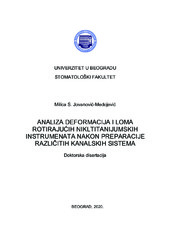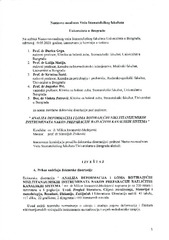Приказ основних података о дисертацији
Analiza deformacija i loma rotirajućih nikltitanijumskih instrumenata nakon preparacije kanalskih sistema
Analysis of deformation and fragment breakage of rotary nickeltitanium instruments after preparation of different root canal systems
| dc.contributor.advisor | Živković, Slavoljub | |
| dc.contributor.other | Grga, Đurica | |
| dc.contributor.other | Matija, Lidija | |
| dc.contributor.other | Šarić, Kristina | |
| dc.contributor.other | Ilić, Jugoslav | |
| dc.creator | Jovanović-Medojević, Milica | |
| dc.date.accessioned | 2022-05-25T07:16:27Z | |
| dc.date.available | 2022-05-25T07:16:27Z | |
| dc.date.issued | 2021-11-20 | |
| dc.identifier.uri | https://eteze.bg.ac.rs/application/showtheses?thesesId=8533 | |
| dc.identifier.uri | https://fedorabg.bg.ac.rs/fedora/get/o:25521/bdef:Content/download | |
| dc.identifier.uri | https://plus.cobiss.net/cobiss/sr/sr/bib/65563657 | |
| dc.identifier.uri | https://nardus.mpn.gov.rs/handle/123456789/19047 | |
| dc.description.abstract | Savremena klinička endodoncija je težak i zahtevan mikrohiruški zahvat koji se sastoji se od niza postupaka, počev od formiranja kaviteta i pristupa kanalima pa sve do adekvatne trodimenzionalne opturacije očišćenog endodontskog prostora. Da bi bila uspešna, endodontska terapija mora zadovoljiti biološke i mehaničke ciljeve. Biološki aspekt se sprovodi adekvatnim debridmanom i dezinfekcijom unutrašnjeg endodontskog prostora, dok se mehanički ostvaruje preparacijom kanala u vidu konusa, uz maksimalno čuvanje originalne endodontske morfologije. Tokom poslednjih decenija, mašinska obrada kanala korena uz primenu nikltitanijumskih (NiTi) instrumenata, postala je standardna klinička procedura. Mašinski NiTi instrumenti, različitog dizajna i veličine, omogućili su lakšu i bržu instrumentaciju uklanjajući manju količinu dentina, uz značajno manju kanalnu transportaciju, bolju mogućnost centritanja duž kanala i bolju prilagođenost povijenosti kanala korena, posebno u apikalnoj zoni. Primena NiTi za izradu rotirajućih endodontskih instrumenata iskoristila je superelastična svojstva legure, njenu sposobnost povratka u prvobitni oblik (shape-memory effect), kao i visok stepen otpornosti na koroziju. Upotreba rotirajućih NiTi instrumenata u endodontskoj proceduri znatno olakšava i ubrzava njeno izvođenje, ali sa mogućnošću pojave proceduralnih greški (promena oblika kanala, formiranje stepenika i useka, transportacija, perforacija zida kanala, formiranje peščanog sata i fraktura instrumenta u kanalu). Fraktura NiTi instrumenta je najkompleksnija greška tokom mašinske instrumentacije. Za razliku od instrumenata od nerđajućeg čelika koji se vidno deformišu pre frakture, rotirajući NiTi instrumenti se vrlo često lome bez upozorenja i vidljivih znakova deformacije. Fraktura mašinskih NiTi instrumenata može nastati kao rezultat torzionog naprezanja, cikličnog zamora, ili kombinacijom ova dva faktora. Mogućnost frakture NiTi instrumenata svakako je povećana njihovom primenom u povijenim kanalskim sistemima ali i korišćenjem prekomerne sile tokom instrumentacije. Prisustvo iregularnosti površinske strukture i taloženje različitih naslaga na novim nekorišćenim instrumentima takođe može uticati na deformaciju i lom ovih instrumenata. Mogućnost deformacije ili čak loma instrumenata zavisi od brojnih različitih faktora: vrste materijala od kog su izrađeni instrumenti, anatomskih osobina kanala koji se obrađuju, dinamike i učestalosti primene instrumenata u kanalu, načina pripreme i sterilizacije, dizajna radnog dela instrumenta, kao i primene različitih hemijskih sredstava tokom instrumentacije. Svi ovi faktori su svakako i u bliskoj vezi sa manuelnom spretnošću i stručnošću terapeuta. Zalomljeni instrumenti su definitivno smetnja pri obradi, irigaciji i opturaciji kanala korena i mogu nepovoljno uticati na ishod endodontske terapije. Teškoće pri uklanjanu zalomljenih fragmenata mogu uzrokovati prekomerno uklanjanje dentina korena, što dodatno može oslabiti koren, ili čak dovesti do njegove perforacije. Posledice koje ova komplikacija uzrokuje, najčešći su razlog izbegavanja mašinske instrumentacije u endodontskoj proceduri. Imajući u vidu važnost predviđanja eventualnog loma NiTi rotirajućih turpija postavljen je osnovni CILJ istraživanja analize i provere površinskih i strukturnih promena, odnosno, nanostrukturnih karakteristika novih i NiTi rotirajućih instrumenata upotrebljenih u kanalskim sistemima različite povijenosti... | sr |
| dc.description.abstract | Modern clinical endodontics is a difficult and demanding microsurgical procedure that consists of a series of procedures, ranging from cavity formation and access to the canals to adequate threedimensional obturation of the cleaned endodontic space. To be successful, endodontic therapy must meet biological and mechanical goals. The biological aspect is carried out by adequate debridement and disinfection of the internal endodontic space, while mechanically it is achieved by cone preparation, with maximum preservation of the original endodontic morphology. In past decades, rotary root canal treatment using nickel-titanium (Ni-Ti) instruments has become a standard clinical procedure. Rotary Ni-Ti instruments of different design and size, have made instrumentation easier and faster by removing less dentin, with significantly less canal transportation, better centering along the canal, and better adaptation to root canal curvature, especially in the apical zone. The use of Ni-Ti for the manufacture of rotary endodontic instruments utilizes the super-elastic properties of the alloy (shape-memory effect) as well as a high degree of corrosion resistance. The use of rotary Ni-Ti instruments in the endodontic procedure greatly facilitates and accelerates the performance, but with the possibility of procedural errors (change of canal shape, step and ledge formation, transportation, canal wall perforation, hourglass formation and instrument fracture in the canal). Ni-Ti instrument fracture is the most complex error during rotary instrumentation. Unlike stainless steel instruments that are visibly deformed before fracture, rotating Ni-Ti instruments often break without warning and visible signs of deformation. Fracture of rotary Ni-Ti instruments can result from torsional stress, cyclic fatigue, or a combination of these two factors. The possibility of fracture of Ni-Ti instruments is certainly increased by their application in curved canal systems but also by the use of excessive force during instrumentation. The presence of irregularities in the surface structure and the deposition of different deposits on new unused instruments can also influence the deformation and fracture of these instruments. The possibility of deformation or even fracture of instruments depends on a number of factors: the type of material from which the instruments are made, the anatomical properties of the canals being processed, the dynamics and frequency of application of the instruments in the canal, the method of preparation and sterilization, the design of the working part of the instrument, as well as the application of different chemical agents during instrumentation. All of these factors are certainly closely related to the therapist's manual dexterity and expertise. Broken instruments are a serious impediment to the treatment, irrigation, and obturation of the root canal and may adversely affect the outcome of endodontic therapy. Difficulties in removing broken fragments can cause excessive dentin removal of the root, which can further weaken the root, or even lead to its perforation. The consequences of this complication are the most common reason for avoiding rotary instrumentation in an endodontic procedure... | en |
| dc.format | application/pdf | |
| dc.language | sr | |
| dc.publisher | Универзитет у Београду, Стоматолошки факултет | sr |
| dc.rights | openAccess | en |
| dc.rights.uri | https://creativecommons.org/licenses/by-nc-nd/4.0/ | |
| dc.source | Универзитет у Београду | sr |
| dc.subject | NiTi instrumenti | sr |
| dc.subject | Ni-Ti instruments | en |
| dc.subject | deformacije | sr |
| dc.subject | frakture | sr |
| dc.subject | SEM-EDS | sr |
| dc.subject | OMIS | sr |
| dc.subject | deformation | en |
| dc.subject | fracture | en |
| dc.subject | SEM-EDS | en |
| dc.subject | OMIS | en |
| dc.title | Analiza deformacija i loma rotirajućih nikltitanijumskih instrumenata nakon preparacije kanalskih sistema | sr |
| dc.title.alternative | Analysis of deformation and fragment breakage of rotary nickeltitanium instruments after preparation of different root canal systems | en |
| dc.type | doctoralThesis | |
| dc.rights.license | BY-NC-ND | |
| dcterms.abstract | Живковић, Славољуб; Матија, Лидија; Грга, Ђурица; Шарић, Кристина; Илић, Југослав; Јовановић-Медојевић, Милица; Aнализа деформација и лома ротирајућих никлтитанијумских инструмената након препарације каналских система; Aнализа деформација и лома ротирајућих никлтитанијумских инструмената након препарације каналских система; | |
| dc.identifier.fulltext | http://nardus.mpn.gov.rs/bitstream/id/142816/Referat_JovanovicMedojevic.pdf | |
| dc.identifier.fulltext | http://nardus.mpn.gov.rs/bitstream/id/142815/Disertacija_12175.pdf | |
| dc.identifier.rcub | https://hdl.handle.net/21.15107/rcub_nardus_19047 |



